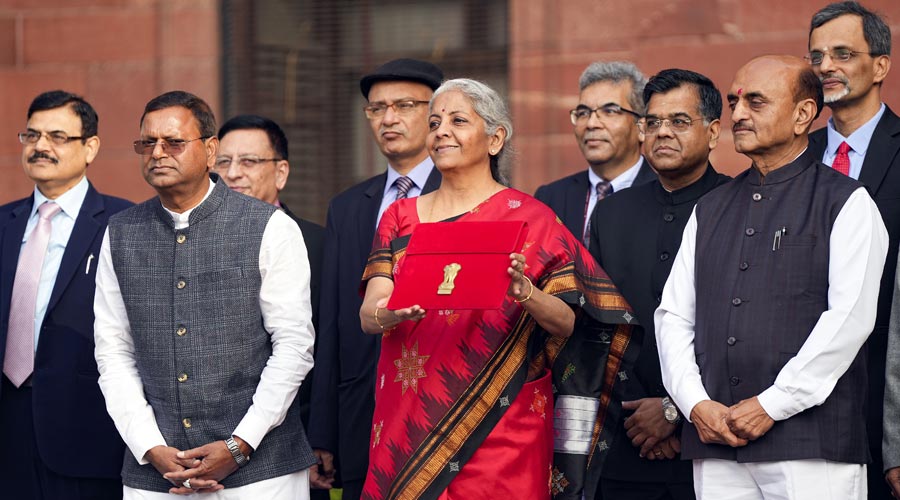To move or not to move… that is the question.
In revamping and incentivizing the personal income tax structure under the new tax regime while simultaneously retaining the old regime as an option to choose, finance minister Nirmala Sitharaman seems to have only added to the complexity and confusion on whether the average middle class needs to shift from the old order to the new… a confusion she purportedly set out to clarify in her budget speech on Wednesday.
“An individual with an annual income of Rs 9 lakh will be required to pay only 45,000. This is only 5 per cent of his or her income. It is a reduction of 25 per cent on what he or she is required to pay now, ie, Rs 60,000. Similarly, an individual with an income of Rs 15 lakh would be required to pay only Rs 1.5 lakh or 10 per cent of his or her income, a reduction of 20 per cent from the existing liability of Rs 1,87,500,” the finance minister stated in her budget speech while clarifying that the benefit would be extended only to taxpayers under the new regime and that the tax structure of the old regime would remain unchanged.
The explainer was in the light of Sitharaman’s announcements of raising the tax rebate limit to Rs 7 lakhs for those opting for the new regime from the existing cap of Rs 5 lakhs and proposing a reduction of the number of tax slabs from six to five with the exemption limit increased to Rs 3 lakhs from the earlier Rs 2.5 lakhs.
Clearly, in the examples cited by the finance minister in her budget speech, the Rs 7 lakh rebate limit for those opting for the new regime does not apply. A person earning Rs 9 lakh annually would pay an income tax of Rs 45,000 because as per the new tax slabs, he/she pays zero tax for the first Rs 3 lakhs, Rs 15,000 tax as 5 per cent of next Rs 3 lakhs and another Rs 30,000 as 10 per cent of his final Rs 3 lakhs earnings, which adds up to Rs 45,000. So, what happens to the Rs 7 lakh rebate limit? It doesn’t apply in this case because the earnings individual in question exceeds that limit.
A simple calculation of the proposed tax structure shows that even if the annual Gross Total Income (GTI) of a person exceeds by Rs 10, then he/she incurs a tax liability of Rs 26,000.
“The decision of which tax regime to choose will depend on your calculations based on the deductions you take vis a vis your gross income. There is no simple way of understanding which one would be more beneficial. For some who may choose to opt for the new regime, things would be simplified because then one doesn’t need to go through the trouble of filing IT returns since the data from Form 26A will get automatically pulled into the return and you can remain happy simply by paying the calculated tax amount,” a direct tax expert, requesting anonymity, said.
“The decision to choose between the two regimes is completely subjective and will depend on your gross income. There is no simple formula for that choice,” he added.
For the salaried class and pensioners, including family pensioners, the finance minister proposed to extend the benefit of standard deduction, earlier applicable to the old regime only, to the new tax regime. "Each salaried person with an income of Rs 15.5 lakh or more will thus stand to benefit by Rs 52,500," she said.
“The whole purpose of any tax reform is to simplify the structure of taxation. From what the finance minister has said today, it has become all the more difficult for an average middle class individual to ascertain which regime he or she needs to opt for. By keeping both regimes open, she has only boosted business of Chartered Accountants and Financial Consultants to whom the common man would now need to run to for tax advice,” said Prasenjit Bose, economist and activist.
“Going by the FM’s own examples, it seems that individuals who are in the annual earning bracket of more than Rs 15 lakhs would stand to gain from the new tax regime. But the financial benefits of those who are below that bracket, and I have reasons to believe they form the majority of the middle class in this country, would be marginal, if at all,” Bose added.
Then there are those in Calcutta’s financial market who believe that the move to enhance rebate limit under the new regime, where there is no obligatory requirement to invest in tax savings schemes and insurance plans, and making it the default tax regime could deal a body blow to the middle class’s propensity to save in life insurance policies.
The Rs 7 lakh rebate with the new regime has been fixed to neutralise any extra benefit that could be had through the old regime's allowable deductions and leave no significant gain in remaining attached with the old regime with allowable deductions, they say.
“Every ongoing insurance scheme will be affected because of this announcement and that’s evident from the fact that the stocks of all life insurance companies are already in the red,” said Rajat Bose, equity analyst.
And there are others who consider the move as a significant policy shift where the government would no more provide tax breaks to incentivize savings.
“This is in line with the Centre’s revenue policy to increase GDP share of indirect taxes over direct taxes and encourage consumption over savings. The problem with this policy in our society with significant socio-economic gaps is that the rich and poor end up paying the same taxes unlike indirect taxation structure where the rich get taxed more than the economically weak,” said an expert on financial matters, asking not to be named.










